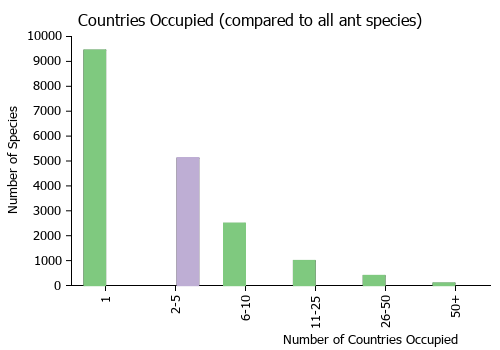Aenictogiton fossiceps
| Aenictogiton fossiceps | |
|---|---|

| |
| Scientific classification | |
| Kingdom: | Animalia |
| Phylum: | Arthropoda |
| Class: | Insecta |
| Order: | Hymenoptera |
| Family: | Formicidae |
| Subfamily: | Dorylinae |
| Genus: | Aenictogiton |
| Species: | A. fossiceps |
| Binomial name | |
| Aenictogiton fossiceps Emery, 1901 | |
Aenictogiton fossiceps is only known from males, as is the case for all its congeners. The biology of this enigmatic genus remains a mystery. Brown (1975) mentioned the possibility that these ants are subterranean or otherwise strongly cryptobiotic; no foraging worker nor any trace of a colony has ever been found. Phylogenetic and morphological affinities to the army ant genus Dorylus suggest an army-ant-like lifestyle, although there is no current evidence for this. Most males were collected from light traps close to forest localities, indicating that Aenictogiton might prefer forested habitats. (Garcia, Wiesel and Fischer 2013)
Identification
Distribution
Latitudinal Distribution Pattern
Latitudinal Range: -5.7° to -15.85601°.
| North Temperate |
North Subtropical |
Tropical | South Subtropical |
South Temperate |
- Source: AntMaps
Distribution based on Regional Taxon Lists
Afrotropical Region: Democratic Republic of Congo (type locality), Zambia.
Distribution based on AntMaps
Distribution based on AntWeb specimens
Check data from AntWeb
Countries Occupied
| Number of countries occupied by this species based on AntWiki Regional Taxon Lists. In general, fewer countries occupied indicates a narrower range, while more countries indicates a more widespread species. |

|
Estimated Abundance
| Relative abundance based on number of AntMaps records per species (this species within the purple bar). Fewer records (to the left) indicates a less abundant/encountered species while more records (to the right) indicates more abundant/encountered species. |

|
Biology
Castes
Nomenclature
The following information is derived from Barry Bolton's Online Catalogue of the Ants of the World.
- fossiceps. Aenictogiton fossiceps Emery, 1901d: 49, figs. 3,4 (m.) DEMOCRATIC REPUBLIC OF CONGO.
- Type-material: holotype male.
- Type-locality: Democratic Republic of Congo: (no further data) (Staudinger & Bang-Haas).
- Type-depository: MSNG.
- Status as species: Emery, 1910b: 27; Wheeler, W.M. 1922a: 750; Santschi, 1924b: 200 (in key); Brown, 1975: 45; Bolton, 1995b: 58.
- Distribution: Democratic Republic of Congo.
Description
References
- Brown, W.L. 1975. Contributions toward a reclassification of the Formicidae. V. Ponerinae, tribes Platythyreini, Cerapachyini, Cylindromyrmecini, Acanthostichini, and Aenictogitini. Search Agriculture Entomology (Ithaca) 5: 1–115.
- Emery, C. 1901d. Note sulle Doriline. Bull. Soc. Entomol. Ital. 33: 43-56 (page 49, figs. 3, 4 male described)
- Hita Garcia, F.; Wiesel, E.; Fischer, G. 2013. The ants of Kenya (Hymenoptera: Formicidae) - faunal overview, first species checklist, bibliography, accounts for all genera, and discussion on taxonomy and zoogeography. Journal of East African Natural History 101:127-222. DOI: 10.2982/028.101.0201
References based on Global Ant Biodiversity Informatics
- Borowiec M. L. 2016. Generic revision of the ant subfamily Dorylinae (Hymenoptera, Formicidae). ZooKeys 608: 1–280.